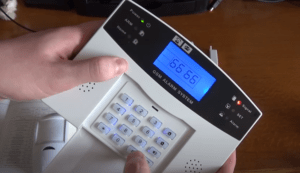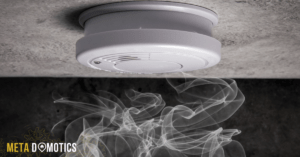Wireless alarm systems are security and safety systems that transmit signals and communicate with other system components via radio frequencies (RF).
They include sensors such as motion detectors, door/window contacts, glass break detectors, smoke alarms, and more.
When one of these devices detects an alarm, it sends a signal to the control panel, which can then initiate an alarm or alert.
RF frequency is important for wireless alarm systems because it helps the system send signals between its different parts.
The signal tells the control panel when an alarm has been triggered, such as from a motion detector or door/window contact. This way, the alarm can sound and alert people if there is a problem.

Definition of RF Frequency
RF frequency is the rate at which an electromagnetic signal is transmitted and received in a wireless alarm system.
RF frequency determines the range of communication within the system, as well as its data transfer rate. A higher frequency will have a shorter range, but faster data transmission rates
How RF Frequency is Measured?
RF frequency is measured in hertz (Hz), with 1 Hz being one cycle per second. It is calculated by dividing the number of cycles per second into the total amount of time for a single transmission.
Generally speaking, RF frequencies for wireless alarm systems are between 300MHz and 900MHz, although this can vary from system to system.
Why RF Frequency is Important in Wireless Communication
RF frequency is important in wireless communication because it influences signal range, speed, and accuracy.
Higher frequencies can travel further and provide faster data transfer rates.
Lower frequencies have a wider range but are slower than higher frequencies.
The RF frequency also influences signal quality: using a frequency that is too low can cause interference and make the system less reliable.
Different Types of RF Frequencies
433MHz
433MHz is a popular frequency for wireless alarm systems because it offers a good balance between range, speed, and accuracy.
868MHz
868MHz provides a longer range but can be slower than 433MHz
915MHz
915MHz is the fastest of the three frequencies but has a shorter range.
Pros & Cons of Using Different RF Frequencies in Wireless Alarm Systems

The advantages and disadvantages of using different RF frequencies in wireless alarm systems depend on the specific frequency being used.
Each frequency offers its own set of benefits and drawbacks, and should be considered when choosing an appropriate frequency for a system.
The range is shorter at 433MHz, one of the most popular frequencies used in wireless alarm systems, than at 868MHz, but the signal remains stable and reliable over a relatively long distance.
This frequency also provides adequate data transfer rates, making it appropriate for medium-sized homes or businesses.
868MHz has a longer range than 433MHz, so it can cover larger areas with fewer repeaters than other frequencies. It is also the most widely used frequency in Europe, making it a popular choice for international companies.
The main disadvantage of 868MHz is that it can be slower than 433MHz due to interference from other nearby frequencies.
Finally, the highest frequency used for wireless alarm systems is 915MHz, which provides the fastest data transfer rates.
It is best suited for use in large homes and businesses due to its long range, but the signal can be weaker over longer distances than 433MHz or 868MHz.
Factors Affecting RF Frequency in Wireless Alarm Systems
Distance between alarm devices.
One of the primary factors influencing the RF frequency in a wireless alarm system is the distance between alarm devices. The lower the frequency of the signal, the further apart two alarms are.
This is because higher frequencies cannot travel as far and are less reliable over longer distances.
Obstacles in the path of the signal.
Obstructions between two alarm devices can also affect the frequency of the signal. Walls, furniture, and other objects can block or weaken the signal, making the alarm difficult to hear.
In these situations, a lower frequency is more likely to pass through the obstruction and arrive at its destination.
Conclusion
In conclusion, it is important to choose the right RF frequency for your wireless alarm system based on distance and obstructions.
By understanding how different frequencies work, you can ensure that the signal will be heard clearly from one location to another.
As technology advances, we are likely to see more options available in terms of RF frequency and other features which could improve reliability even further.
With these advancements, wireless alarm systems should become increasingly effective at providing security and peace of mind for homeowners and business owners alike.







